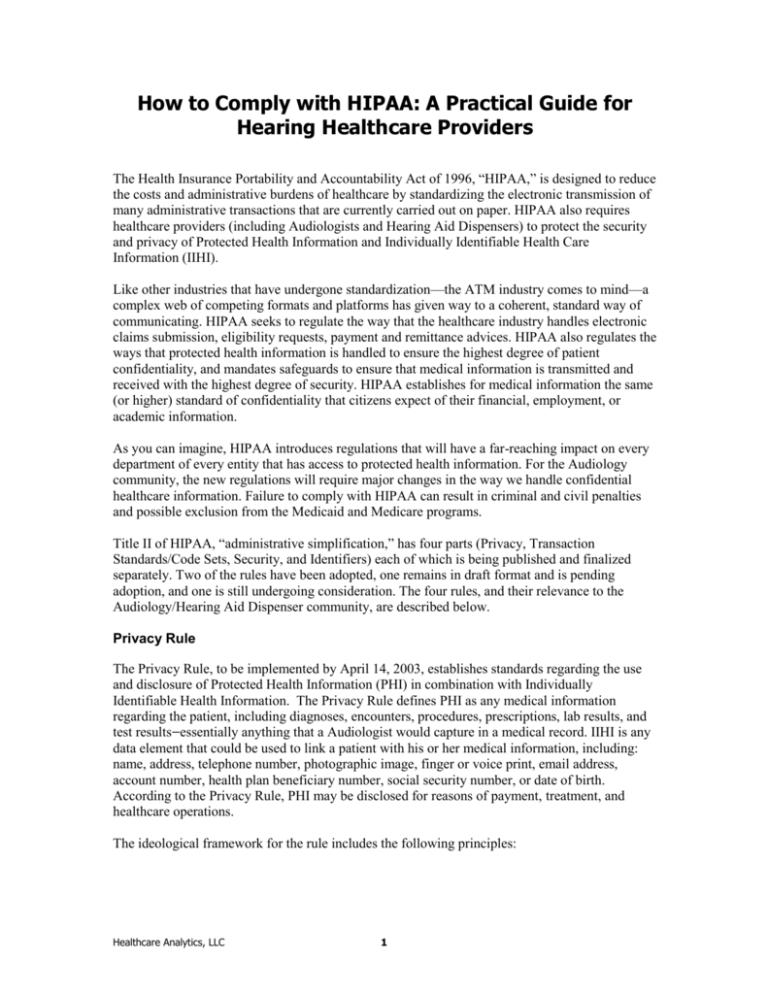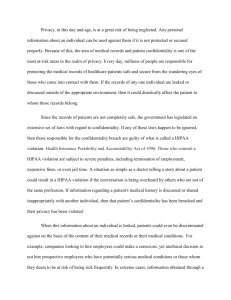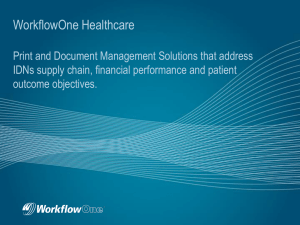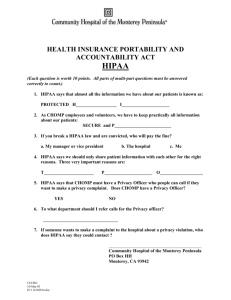How to Comply with HIPAA: A Practical Guide
advertisement

How to Comply with HIPAA: A Practical Guide for Hearing Healthcare Providers The Health Insurance Portability and Accountability Act of 1996, “HIPAA,” is designed to reduce the costs and administrative burdens of healthcare by standardizing the electronic transmission of many administrative transactions that are currently carried out on paper. HIPAA also requires healthcare providers (including Audiologists and Hearing Aid Dispensers) to protect the security and privacy of Protected Health Information and Individually Identifiable Health Care Information (IIHI). Like other industries that have undergone standardization—the ATM industry comes to mind—a complex web of competing formats and platforms has given way to a coherent, standard way of communicating. HIPAA seeks to regulate the way that the healthcare industry handles electronic claims submission, eligibility requests, payment and remittance advices. HIPAA also regulates the ways that protected health information is handled to ensure the highest degree of patient confidentiality, and mandates safeguards to ensure that medical information is transmitted and received with the highest degree of security. HIPAA establishes for medical information the same (or higher) standard of confidentiality that citizens expect of their financial, employment, or academic information. As you can imagine, HIPAA introduces regulations that will have a far-reaching impact on every department of every entity that has access to protected health information. For the Audiology community, the new regulations will require major changes in the way we handle confidential healthcare information. Failure to comply with HIPAA can result in criminal and civil penalties and possible exclusion from the Medicaid and Medicare programs. Title II of HIPAA, “administrative simplification,” has four parts (Privacy, Transaction Standards/Code Sets, Security, and Identifiers) each of which is being published and finalized separately. Two of the rules have been adopted, one remains in draft format and is pending adoption, and one is still undergoing consideration. The four rules, and their relevance to the Audiology/Hearing Aid Dispenser community, are described below. Privacy Rule The Privacy Rule, to be implemented by April 14, 2003, establishes standards regarding the use and disclosure of Protected Health Information (PHI) in combination with Individually Identifiable Health Information. The Privacy Rule defines PHI as any medical information regarding the patient, including diagnoses, encounters, procedures, prescriptions, lab results, and test results—essentially anything that a Audiologist would capture in a medical record. IIHI is any data element that could be used to link a patient with his or her medical information, including: name, address, telephone number, photographic image, finger or voice print, email address, account number, health plan beneficiary number, social security number, or date of birth. According to the Privacy Rule, PHI may be disclosed for reasons of payment, treatment, and healthcare operations. The ideological framework for the rule includes the following principles: Healthcare Analytics, LLC 1 Minimum necessary disclosure of PHI All healthcare providers and payers need to publish their privacy practices All healthcare providers need to ensure that their Business Associates are taking steps to safeguard PHI in their possession All healthcare providers need to appoint a Privacy Officer and take steps to safeguard PHI The source of an Audiologist’s compliance risk accrues from patient medical information that it receives, stores, and transmits. In the course of treating patients and submitting healthcare claims on behalf of their patients, members of the Audiology community routinely handle, store, and disseminate large volumes of PHI. To mitigate this risk, Audiologists and Hearing Aid Dispensers will need to put in place reasonable safeguards to ensure that PHI is not compromised. Transaction Standards/Code Sets The rule standardizing Transaction Standards and Code Sets establishes a single set of transaction standards for electronic healthcare transactions, enabling payers and providers to communicate more fluidly. The rule, which requires implementation no later than October 16, 2002 (or by October 16, 2003 for healthcare providers who submit an extension request no later than October 15, 2002), includes standards for the following healthcare transactions performed electronically: Healthcare claims (837 Professional, Institutional, and Dental) Health plan eligibility inquiries/responses (the ANSI 270/271) Enrollment and disenrollment from a health plan (834) Healthcare payment/remittance advice (835) Health plan premium payments (820) Claim status inquiries/responses (276/277) Referral certification and authorization (278) The Rule also requires healthcare providers to use the following code sets, many of which are currently embraced by Audiologists: Diagnosis and inpatient procedures (ICD-9) Physician procedures (CPT-4) Products (HCPCS) Drug Products (NDC) Under this construct, electronic Audiology claims would be submitted using the 837 Professional format. The Department of Health and Human Services, working in collaboration with its Designated Standards Making Organizations adopted these national uniform standards. The standard does not disallow the submission of paper-based claims; Audiologists may continue submitting claims on the HCFA 1500 form. It does, however, require that the standards be followed whenever transactions are conducted electronically. Since many Audiologists submit the paper-based HCFA 1500 form, they are, strictly speaking, not touched by HIPAA’s Transaction Standard/Code Set requirements. However, going forward, commercial insurance companies are expected to recoup the expense of adopting the new standards by discouraging their providers from submitting claims on paper. Healthcare Analytics, LLC 2 Security Rule The Security Rule, currently in draft and pending adoption, will provide a uniform level of protection for health information that is housed or transmitted electronically. The Security standard mandates safeguards to protect an individual’s health information, while permitting the use of that information by healthcare providers, payers, and clearinghouses. According to the proposed rules (pending finalization), it is permissible to use the Internet to transmit confidential patient information, as long as an acceptable method of encryption is used to protect confidentiality, and appropriate authentication procedures are used to ensure the identity of the sender and receiver. Since many Audiologists receive, store, and transmit PHI in electronic format, they will need to put in place reasonable safeguards to ensure that PHI is not compromised. Healthcare providers and payers will need to: Review their security management procedures Undertake internal security reviews and certifications Create and implement security awareness training programs for employees Review contingency plans that may affect the transmission of healthcare information Establish physical safeguards to protect information on workstations, in the physical work environment, and stored on electronic media (including protected health information resident on PDAs, laptops, and other devices that may leave the office) Ensure that access to medical information is controlled and restricted to essential personnel Authenticate data sent and received Identifiers Today, health plans assign identification numbers to healthcare providers—individuals, groups, or organizations that provide medical services or health supplies. The result is that providers who do business with multiple health plans have multiple identification numbers. The proposed National Provider Identifier and National Employer Identifier are unique identification numbers for healthcare providers that will be used by all health plans. HIPAA’s Three Primary Constituent Groups HIPAA impacts three constituent groups, as follows: Patients Covered Entities: healthcare providers, payers, assisted living facilities, hospitals, clearinghouses, health plans, etc.) Business Associates (i.e., lawyers, consultants, medical device manufacturers, software developers, accountants, trading partners, billing companies, collections agencies, etc.). Most Audiologists are Covered Entities and are required to comply with all of the adopted rules. Covered Entities are regulated by the federal government and, thereby, subject to sanctions for non-compliance. Covered Entities are also required to mitigate their risk by enrolling their Healthcare Analytics, LLC 3 Business Associates in Business Associate Agreements or chain-of-trust agreements. Covered Entities are also required to take steps to ensure that their Business Associates are taking reasonable steps to safeguard PHI and to terminate business relationships, when feasible, with Business Associates that are non-compliant. How Should Audiologists Prepare for HIPAA We recommend that Audiologists (and, for that matter, all healthcare providers), take the following steps to prepare for HIPAA. 1. Understand the laws and regulations, and how they apply to the Audiology/Hearing Aid Dispenser community. 2. Understand the responsibilities of Covered Entities (and the penalties that can be applied to Covered Entities for non-compliance). 3. Understand which transactions are covered under HIPAA, which ones you currently perform, and what steps you’ll need to take to comply with the new Transaction Standards/Code Sets. 4. Understand when Protected Health Information can be disclosed, to whom, and how. 5. Look at your current practices for storing and sharing information, then ask: Who needs the information, and why? Why am I accessing or sharing this information? Is there a legitimate reason why I need to share this information? 6. Implement policies and procedures to meet the requirement. 7. Implement HIPAA’s administrative requirements: appoint a Privacy Officer, post a Notice of Privacy Practices, and develop a series of documented policies and procedures for the use and disclosure of Protected Health Information. 8. Develop a well-informed point of contact to respond to questions regarding your HIPAA practices. Getting More Information For more information regarding HIPAA, consult the following web sites: CMS’s HIPAA Administrative Simplification website contains the preliminary and final regulations, program memoranda, and FAQs: http://aspe.hhs.gov/admnsimp/Index.htm. This site also contains access to an electronic extension request utility. The Washington Publishing Company website offers free-downloads of the Transaction Standard and Code Set Implementation Guides: www.wpc-edi.com The Healthcare Financial Management Association’s HIPAA pages contain a wide spectrum of resources: http://www.hfma.org/kn/hipaa.htm Healthcare Analytics, LLC 4 IBM’s National HIPAA Practice website contains case studies and white papers on HIPAA: http://houns54.clearlake.ibm.com/solutions/healthcare/helpub.nsf/detailcontacts/Solition_Hea lthcare_Security Phoenix Health’s http://www.HIPAAdvisory.com offers searchable access to the regulations and regular, topical updates. Dan Jacob, founder of Healthcare Solutions, is a HIPAA expert serving the Audiology community. For questions regarding this article and the applicability of HIPAA to Audiologists and hearing device manufacturers, please contact Mr. Jacob at Jacob_Dan@hotmail.com. Healthcare Analytics, LLC 5







